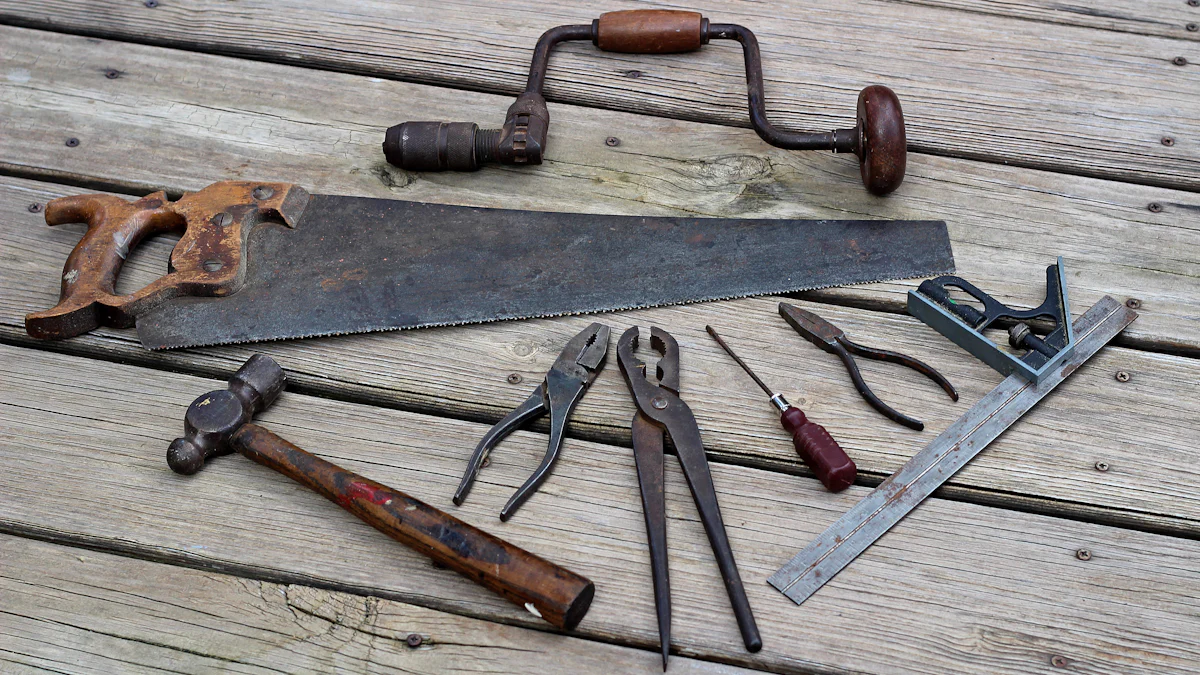
Every home improvement project needs the right hardware tool. A good tool simplifies tasks and ensures success. Many households have increased spending on DIY projects. This trend highlights the importance of having essential tools at home. You might wonder why some projects fail. The absence of proper tools often leads to incomplete tasks. Investing in quality tools saves time and effort. Think about the satisfaction of fixing things yourself. A well-equipped toolbox empowers you to tackle any challenge.
Hand Tools

Overview of Hand Tools
Definition and Purpose
Hand tools are essential for any home improvement project. These tools do not require electricity or batteries. You can use hand tools for a variety of tasks around the house. The primary purpose of hand tools is to provide control and precision. You can rely on them for tasks that need a delicate touch. Every homeowner should have a basic set of hand tools in their toolbox.
Common Examples
You might wonder what tools fall under this category. Here are some common examples:
- Hammers: Perfect for driving nails and small demolition tasks.
- Screwdrivers: Essential for assembling furniture and performing repairs. Both flathead and Phillips types are necessary.
- Pliers: Useful for gripping, twisting, and cutting wires or small objects.
- Wrenches: Ideal for loosening or tightening nuts and bolts. Adjustable and socket types are popular choices.
Benefits of Hand Tools
Versatility
Hand tools offer incredible versatility. You can use them for a wide range of tasks. Whether you need to fix a leaky faucet or hang a picture frame, hand tools come in handy. Their design allows you to perform various functions with ease. You can switch between tasks without needing different tools.
Ease of Use
Ease of use is another significant advantage of hand tools. You don’t need special skills or training to use them. Most hand tools have simple designs. You can quickly learn how to operate them. This simplicity makes them accessible to everyone. Even beginners can handle basic repairs with confidence.
Power Tools

Overview of Power Tools
Definition and Purpose
Power tools transform home improvement projects. These tools use electricity or batteries to operate. You can handle tasks that require more strength and speed than hand tools. Power tools make heavy-duty jobs manageable. Every homeowner benefits from having power tools in their arsenal.
Common Examples
Power tools come in various forms. Here are some common examples:
- Drills: Perfect for creating holes in wood, metal, or concrete.
- Saws: Essential for cutting through materials like wood and plastic.
- Sanders: Useful for smoothing surfaces and removing paint.
- Nail Guns: Ideal for driving nails quickly and efficiently.
Advantages of Power Tools
Efficiency
Power tools offer unmatched efficiency. You complete tasks faster with less effort. Imagine drilling a hole in seconds instead of minutes. Power tools save time and energy. You can tackle multiple projects in one day. Efficiency makes power tools indispensable for home use.
Precision
Precision stands out as a key benefit of power tools. You achieve cleaner cuts and smoother finishes. Power tools provide consistent results every time. Imagine cutting a straight line with ease. Precision enhances the quality of your work. Home projects look professional with power tools.
Expert Testimony:
Power Tools Expert Witnesses state that power tools reduce the risk of workplace accidents. Proper use ensures safety and accuracy in construction tasks.
Investing in power tools elevates your DIY experience. You gain access to a world of possibilities. The right hardware tool transforms your approach to home improvement. Embrace the power and precision that these tools offer.
Cutting Tools
Overview of Cutting Tools
Definition and Purpose
Cutting tools play a vital role in home improvement tasks. These tools help you slice, trim, or shape materials with precision. A good cutting tool makes your job easier and more efficient. You can use cutting tools for various projects around the house. Every homeowner should have a reliable set of cutting tools in their toolbox.
Common Examples
You might wonder what types of cutting tools you need. Here are some common examples:
- Knives: Perfect for slicing through different materials. Utility knives are handy for cutting boxes, ropes, and other items.
- Scissors: Essential for trimming paper, fabric, and other lightweight materials.
- Box Cutters: Ideal for opening packages and cutting through cardboard.
- Saws: Useful for cutting wood and other sturdy materials.
Importance of Cutting Tools
Safety Considerations
Safety should always come first when using cutting tools. Sharp blades can cause injuries if not handled properly. Always wear protective gloves to safeguard your hands. Keep your fingers away from the blade’s path. Make sure to store cutting tools in a safe place. A secure storage area prevents accidents and keeps tools in good condition.
Maintenance Tips
Proper maintenance extends the life of your cutting tools. Clean the blades after each use to remove debris. Sharpen dull blades to maintain effectiveness. Consider using Slice blades made from zirconium oxide. These blades last up to 11 times longer than traditional metal blades. Regular maintenance ensures your tools remain sharp and ready for any task.
Investing in quality cutting tools enhances your home improvement experience. You gain the ability to tackle various projects with ease. The right hardware tool makes a significant difference in your work. Equip yourself with reliable cutting tools and enjoy the satisfaction of a job well done.
Fastening Tools
Overview of Fastening Tools
Definition and Purpose
Fastening tools are essential for joining or securing materials. These tools provide strength and stability in various projects. You can use fastening tools to assemble furniture, construct structures, or perform repairs. Fastening tools ensure the integrity and longevity of the finished product. These tools make joining materials faster and more efficient than manual methods.
Common Examples
You might wonder which fastening tools are most useful. Here are some common examples:
- Wrenches: Perfect for loosening or tightening nuts and bolts. Adjustable and socket types are popular choices.
- Pliers: Useful for gripping, twisting, and cutting wires or small objects.
- Staple Guns: Ideal for fastening materials together with staples.
- Nail Guns: Allow for quick and efficient nail installation.
- Rivet Guns: Secure metal components by driving rivets into place.
Uses of Fastening Tools
Durability
Fastening tools offer durability in your projects. These tools create strong connections that last. You can rely on fastening tools for tasks that require long-lasting results. Durable connections prevent wear and tear over time. Fastening tools ensure that your work stands the test of time.
Application in Various Tasks
Fastening tools have versatile applications. You can use them in a wide range of tasks. Whether assembling a bookshelf or repairing a fence, fastening tools come in handy. These tools simplify the assembly process. Fastening tools provide reliable connections in various projects. You gain confidence knowing your work is secure.
Investing in quality fastening tools enhances your home improvement experience. You gain the ability to tackle various projects with ease. The right hardware tool makes a significant difference in your work. Equip yourself with reliable fastening tools and enjoy the satisfaction of a job well done.
Choosing the right tools for home use is crucial. Quality tools make home maintenance easier and more efficient. You should explore different options and invest in reliable tools. A well-equipped toolbox empowers you to tackle any home project with confidence. Visit a recommended online store to find the best tools for your needs. Investing in quality tools enhances your DIY experience and ensures successful projects.
